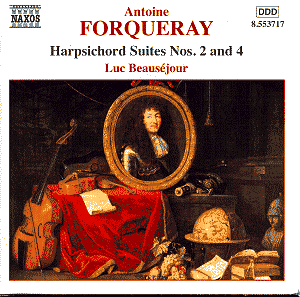These
Suites were written originally for viols and, when edited and
transcribed for harpsichord by Antoine’s son Jean-Baptiste Forqueray,
the same range was kept, hence they utlize the lower range of
the keyboard, giving a rich abdominal growling sound. The melodic
lines are filled out with graces and ornaments, here played unerringly
in the French manner by Beauséjour, who caresses the keys
in a truly loving, sensual manner. An unusually live recording
perspective is employed. The result is grandly musical and entertaining,
particularly in the lyrical sarabandes and intricate chaconnes.
Of
the two Spanish dance forms based on variations over a repeated
bass figure to become popular outside of Spain in the Baroque
and Pre-baroque periods, the passer caille (generally known
in its Italian form, passacaglia, but also occasionally
in the French passacaille) was for the plucked string,
the chacona (known in France as chaconne and England
as chacony) was for the bowed string, and European composers
of the period generally observed this distinction. Bach’s passacaglia
in c BWV 582 was originally for pedal harpsichord* even though
it has been generally played on the organ, whereas the famous
chaconne in d is from the violin suites although today
it is played in arrangements for every instrument. The similar
fandango form, for dance ensemble, was utilized by Boccherini
and Soler in Spain.
Here
Suite 2 movement V is entitled chaconne, but movement II
is also actually such, as are Suite #4 movements I, VI, and Suite
3, movement VII. La Rameau from Suite #5 is a remarkably
dramatic work, almost an operatic scene.
Paul
Shoemaker
see
also review by Rob
Barnett
*My
own arrangement for 4 guitars, including bass guitar, was performed
at Boise State University and generally found effective.

![]() Luc Beauséjour,
harpsichord
Luc Beauséjour,
harpsichord ![]() NAXOS 8.553717 [76.06]
NAXOS 8.553717 [76.06]